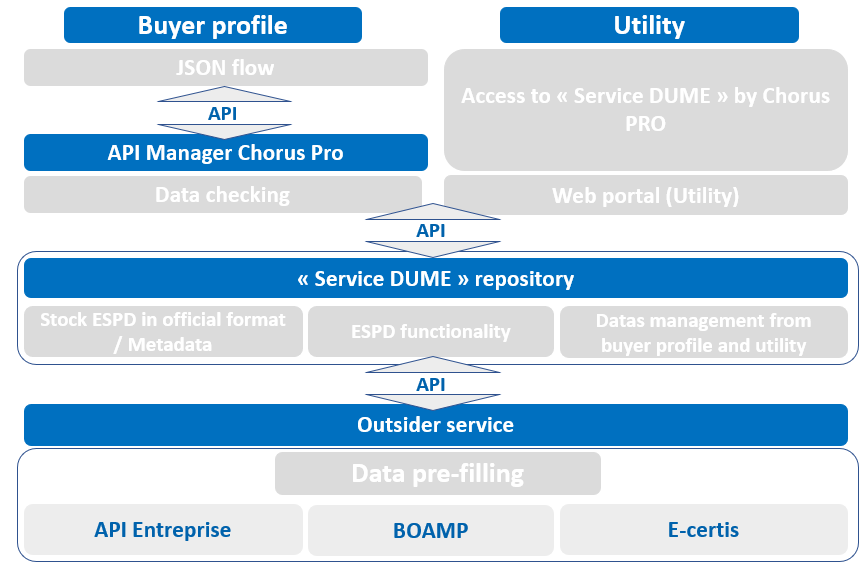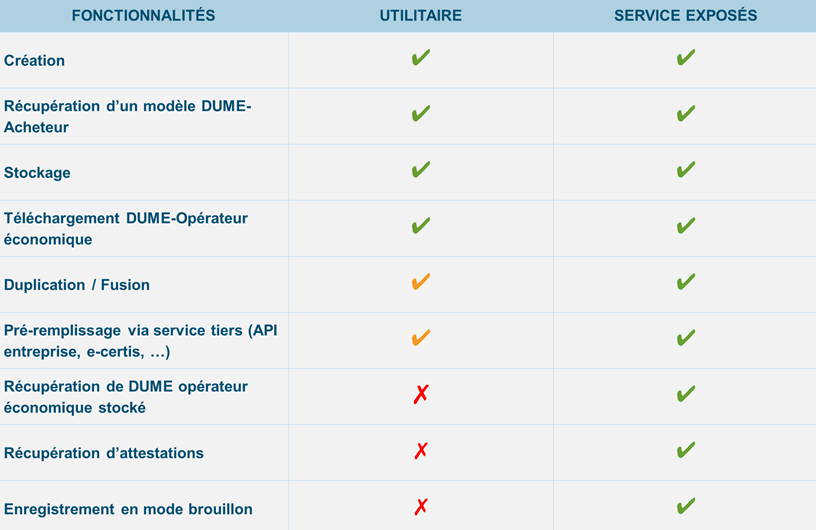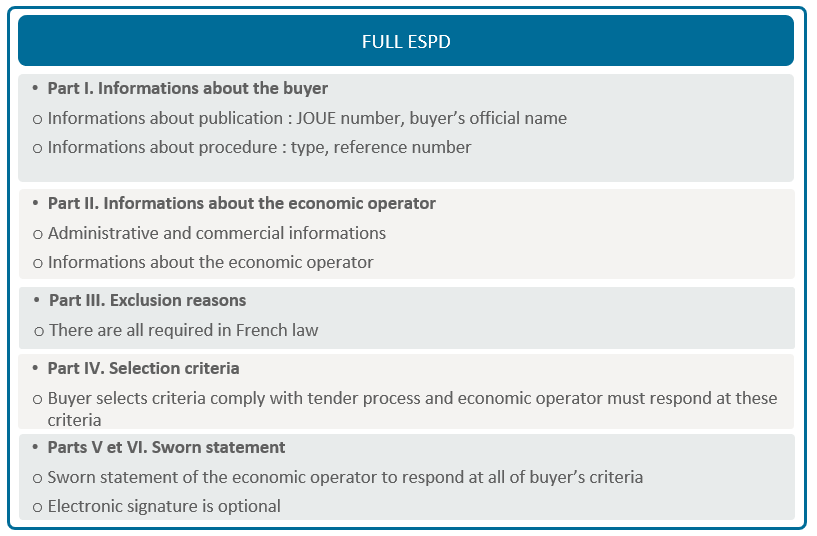ESPD Presentation
The objective of this document is ESPD presentation, his structure and ESPD service's project.
The ESPD is a declaration on honor enabling companies to attest to their competence, their financial situation as well as their capacities when they bid for a public procurement within a European Union state. It is used as preliminary evidence in the administrative offer for public procurements.
The purpose of the ESPD is to simplify the processes of providing documents and certificates attesting to a company’s eligibility for a public procurement (exclusion and selection criteria). In France, the purpose of this document is, among other things, to supersede the DC1 and DC2 forms as well as the “Marché Public Simplifié (“Simplified Public Procurement”) program.
The ESPD is structured acording to a standard form defined at European level. This form was then adapted in order for it to conform to the current national legislations.
In Public order, ESPD fells valued in two times :
In a first time, the Buyer selects some criteria which are completed by a number of economic operator to attested their eligibility. This type of ESPD is called Buyer EPSD (DUME A). ESPD be able to getting used to buyer requirement. Each ESPD is adjustable. ESPD permits to have an exhaustiveness (default option), or to have an engagement on few criteral which are selected by the buyer.
In a second time, the economic operators complete their ESPD on the basis of buyer ESPD and they joined ESPD on buyer profile. This type of ESPD is called Economic operator ESPD (DUME OE). Even if the buyer doesn't created an EPSD, economic operator can create an economic operator ESPD and answer by it.

No certificate is required when submitting the ESPD. However, the buyer can request to recover certain certificates by API enterprises. In the event that certain certificates cannot be automatically returned, the buyer can ask the economic operator to produce supporting certificates.

The operators' ESPDs are then analyzed by the buyer, who thus determines which operators are eligible and able to meet market requirements.
The ESPD therefore intervenes at three stages of the public procurement process:
- Creation of the consultation file by the buyer (creation of the buyer ESPD)
- Response to the call for tenders by the company (creation of the economic operator ESPD)
- Analysis of applications by the buyer
ESPD intervention in public order :

The ESPD intervenes when:
- The buyer creates his consultation file and completes a ESPD by setting selection criteria for the economic operator wishing to apply for the market.
- The economic operator wishes to respond to the administrative offer of a tender issued by a buyer.
- The buyer will consult the ESPDs completed by economic operators to determine whether they are able to participate in the public market.
Ideally, an economic operator can create an OE ESPD in response to an ESPD A:

Economic operator can also respond to a consultation with an ESPD even if the buyer has not himself created an ESPD

The ESPD is a document made up of six parts. We will specify the elements that must be provided by the buyer and the economic operator according to each part below.
a) Part I
Part I enables to provide the information regarding the publication of the contract, the buyer's identification data and the information regarding the procurement procedure.
b) Part II
Part II enables to fill out the economic operator and his representatives’ identification data, as well as the possible call on third party entities’ capacities or subcontracting.
c) Part III
Part III enables the economic operator to indicate that he or she is not concerned by the bans from tendering provided by European and French law.
In French law, all of the exclusion criteria are mandatory. In order not to overload the ESPD, the AIFE (Agence pour l'Informatique Financière de l’État, "National Financial Computing Agency") recommends that the detail of the criteria be displayed in the dematerialized form only if the buyers and economic operators wish to consult them (example: drop-down menu enabling the access to the exclusion criteria detail or tooltips to get a better understanding of them).
The user cannot uncheck any of those crtieria (since they are all mandatory).
By default, all of the criteria are checked "yes" and are not displayed to the user.
In the case when the economic operator answers that he or she is concerned by a ban from tendering, he or she must check "no". All of the fields of parts A, B, C and D will appear so that he or she can indicate which criteria is concerned by the ban from tendering.
d) Part IV
Part IV enables the buyer to put the selection criteria applicable to the procurement procedure in the ESPD. There are thirty-two proposed criteria.
Those criteria enable to meet the requirements that are most frequently requested by buyers in procurement contracts. It is recommended to buyers to fill out this part, in order to enable the economic operator to only answer the criteria relevant to the call for tender. Filling out part IV enables the buyer to only visualize the selection criteria specific to his or her call for tender, which facilitates the studying of the bids phase.
In the case where the buyer doesn't wish to fill out the proposed criteria, he or she can check "no" to the question " souhaitez-vous utiliser les critères de sélection" ("do you wish to use the selection criteria"). Henceforth, the checkbox "l’opérateur économiques peut-il déclarer qu’il satisfait à l’ensemble des critères de sélection" (" can the economic operator affirm that he or she meets all of the selection criteria"), called the "alpha checkbox", is checked and cannot be unchecked.
This "alpha checkbox" gives economic operators the opportunity to convey a general commitment to respecting the criteria listed in the tender rules, without giving any detail when it comes to the infringement of these criteria. Using this checkbox is therefore strongly discouraged in dematerialized mode because, under the guise of facilitating the work of the public procurement process' actors, it makes it more complicated and tedious:
- First, the referral to the tender rules implies that the buyer has entered the entirety of his or her selection criteria in full in the tender rules beforehand, where a standard buyer ESPD could have sufficed.
- Similarly, in dematerialized mode, the economic operator will be obliged to search for his or her criteria in the tender rules, or even to search by him or herself some certificates whose retrieval could have been centralized and stored once and for all via the ESPD Service.
- Lastly, at the examination of applications stage, in dematerialized mode, the buyer denies him or herself the opportunity to automate the comparing of answers formalized in the form of standardized operator ESPDs [comparison tables].
Even if the "alpha checkbox" functionality must be supported by by all buyer profiles in order to meet European ESPD format's requirements, it is important to implement mechanisms to limit its use by actors. They can be warning or information messages triggered when the checkbox is used. Buyer profiles can also consider the possibility of not opening the functionality in ESPD initial entry, but to enable the opening and exploitation of ESPD with the "alpha checkbox" on other platforms. Regarding this matter, it is up to each platform to choose this functionality's appropriate management model.
e) Part V
Part V enables the economic operator to certify that he or she meets the objective and non discriminatory rules to apply in order to limit the number of candidates. This declaration appears when the chosen procedure is not an open procedure and is therefore not systematically present in the ESPD form presented to the user.
f) Part VI
Part VI enables the economic operator to declare on honor that all the provided information is correct. The economic operator must sign the ESPD only if the buyer requires it in the tender rules.
a) Presentation
The "Direction des Affaires Juridiques" of Bercy entrusted in setting up the ESPD service to AIFE (Agence pour l'Informatique Financière de l'Etat) to permit dematerialized ESPD for buyer and economic operator. After six months of experimentation, ESPD service was opened to the maximum of people (if you want to know more, you can download experimentation summary here : https://communaute.chorus-pro.gouv.fr/documentation/dume-premier-bilan-apres-le-retour-dexperience-de-la-phase-pilote/ ).
There are two access at ESPD service. On the one hand, the user can choose to create his ESPD by a buyer profile. On the other hand, he can create his ESPD by ESPD web portal (utility) on Chorus Pro. This portal gives a minimum of functionalities.
Caution ! Utility allows simply to product ESPD but it doesn't allow to create a consultation or answer at it, you should go on buyer profile.
To get all the beneficits of ESPD, you must create your ESPD by buyer profile.

Access to utility is done in unconnected mode. This means that buyer or economic operator deosn't need to log in by a SIRET for example. Moreover, no account creation is requiered.
Access to buyer profile is done in connected mode. Authentification modalities are buyer profile's discretion.
All of ESPD registered by ESPD service are saved by AIFE. They are retrievable with the ESPD id on each buyer profile which are connected at ESPD service's API.
Each ESPD are exploitable on all platforms. It's ESPD service's interoperability.
b) Comparative table of AIFE's utilities
This table below presents all of features of utility and API (services exposés). API allow further use of ESPD.

a) The available solutions
There are two solutions that allow for the creation of ESPDs:
- The ESPD Service gateway (not connected space)
- The buyer profiles (connected spaces)
1. The ESPD Service on the Chorus Pro gateway
It is possible to create an ESPD on the ESPD Service's utility. It is available on the Chorus Pro gateway at the following link.
 The "Access ESPD Service" button enables to have direct access to the ESPD Service's utility's welcome page. Please note that it is not necessary to create a user account on Chorus Pro to access the ESPD Service.
The "Access ESPD Service" button enables to have direct access to the ESPD Service's utility's welcome page. Please note that it is not necessary to create a user account on Chorus Pro to access the ESPD Service.
 To start creating an ESPD, you simply have to click the "Acheteur public" (which means "public procurer") button or the "Entreprise" ("company") button and to select "Créer un DUME" ("Create an ESPD").
To start creating an ESPD, you simply have to click the "Acheteur public" (which means "public procurer") button or the "Entreprise" ("company") button and to select "Créer un DUME" ("Create an ESPD").
Please note that although the page opens in French language by default, you can open it in English by scrolling down the page until you reach the small French flag icon on the lower left of the page. If you click on the flag, you can change the language to English. This will translate the menus (Entreprise becomes Company, and Acheteur Public becomes Procurer).
2. The buyer profiles
The buyer profiles (platforms enabling public entities to publish their calls for tender and companies to respond to the calls for tender) also offer to create ESPD.
The pilot buyer profiles which offer ESPD as of June 15th 2018 are the following:
NB: Those pilot buyer profiles have accompanied the AIFE since the very beginning of the ESPD project. Those entities have implemented the APIs developed by the AIFE, thus attesting to the ESPD form's conformity and its interoperability at the European level.
b) How to use it
1. The ESPD Service utility
The documentation regarding the ESPD Service's utility can be accessed via the Communauté Chorus Pro ("Chorus Pro Community"), under the section "Présentation de l'utilitaire Service DUME" ("Presentation of the ESPD Service utility") or at the following link.
As a reminder, the ESPD Service utility is an unconnected space. It is therefore not necessary to create a Chorus Pro account.
2. The buyer profiles
Please refer to the documents at your disposal on each buyer profile.
Last Update: July 13, 2021




